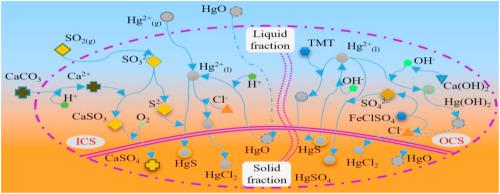Journal of Cleaner Production ( IF 9.7 ) Pub Date : 2020-09-18 , DOI: 10.1016/j.jclepro.2020.124211 Lin Chang , Yi Zhang , Huan Liu , Rong Peng , Xuehai Yu , Yongchun Zhao , Junying Zhang

|
The environmental problem concerning Hg pollution has received worldwide attention. Coal fired power plants are responsible for large amounts of Hg emission and produce abundant by-products in particular gypsum which is capable of extensive use. In this study, the migration of Hg in the gypsum production process and effluent treatment process in a typical wet flue gas desulfurization (WFGD) system was investigated and the temperature programmed decomposition technique was applied to identified Hg species in these products. Hg concentration in both the solid and liquid fraction of samples obtained in wet flue gas desulfurization system were determined by atomic fluorescence spectroscopy. The results indicated that gypsum accounted for a small proportion (29.9%) of Hg while the majority of Hg was transported to effluent treatment process where over 99.6% Hg was removed. The amount of Hg discharged from WFGD in the drainage, gypsum, and desulfurization sludge were 0.04 t/yr, 13.56 t/yr, and 9.56 t/yr, respectively. Desulfurization environment promoted HgS formation and lead to HgS being dominant in gypsum. The alkaline environment in the effluent treatment process contributed to the formation of HgO which was regarded as the primary Hg compound and accounted for 49.5%, 54.8%, and 78.5% of the total Hg in the neutralization tank, precipitation tank, and flocculation tank, respectively. The occurrence of HgCl2 in the solid fraction attributed to absorption of solid particles when it precipitated and was enhanced by the addition of chemicals. There was no obvious difference in the proportion of HgSO4 in the effluent treatment process. Systematic studies on difference in the partitioning of Hg species enables a better understanding on Hg behavior and provides conferences on targeting removal of Hg species in WFGD system.
中文翻译:

程序升温分解法在湿法烟气脱硫系统中汞的迁移和鉴定
有关汞污染的环境问题已引起全世界的关注。燃煤电厂负责排放大量的汞,并产生丰富的副产品,尤其是能够广泛使用的石膏。在这项研究中,研究了汞在典型的湿法烟气脱硫(WFGD)系统中的石膏生产过程和废水处理过程中的迁移,并采用程序升温分解技术对这些产品中的汞物种进行了鉴定。通过原子荧光光谱法测定湿烟气脱硫系统中样品的固相和液相中的汞浓度。结果表明,石膏只占很小的比例(29。9%的Hg,而大部分Hg则转移到废水处理过程中,其中超过99.6%的Hg被去除。废水,石膏和脱硫污泥中WFGD排放的汞量分别为0.04吨/年,13.56吨/年和9.56吨/年。脱硫环境促进了HgS的形成,并导致HgS在石膏中占主导地位。废水处理过程中的碱性环境促进了HgO的形成,HgO被认为是主要的Hg化合物,在中和池,沉淀池和絮凝池中分别占Hg总量的49.5%,54.8%和78.5%,分别。HgCl的发生 脱硫环境促进了HgS的形成,并导致HgS在石膏中占主导地位。废水处理过程中的碱性环境促进了HgO的形成,HgO被认为是主要的Hg化合物,在中和池,沉淀池和絮凝池中分别占Hg总量的49.5%,54.8%和78.5%,分别。HgCl的发生 脱硫环境促进了HgS的形成,并导致HgS在石膏中占主导地位。废水处理过程中的碱性环境促进了HgO的形成,HgO被认为是主要的Hg化合物,在中和池,沉淀池和絮凝池中分别占Hg总量的49.5%,54.8%和78.5%,分别。HgCl的发生固体部分中的2归因于固体颗粒在沉淀时的吸收,并通过添加化学物质而增加。在废水处理过程中,HgSO 4的比例没有明显差异。关于汞物种分配差异的系统研究可以更好地了解汞行为,并提供有关在WFGD系统中去除汞物种的目标会议。











































 京公网安备 11010802027423号
京公网安备 11010802027423号